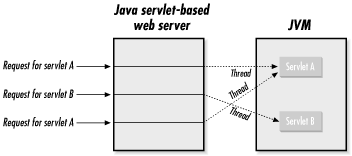Servlet Basics
The Servlet API consists of two
packages,
javax.servlet and
javax.servlet.http.
The javax is there because servlets are a standard
extension to Java, rather than a mandatory part of the API. This
means that while servlets are official Java, Java virtual machine
developers aren’t required to include the classes
for them in their Java development and execution environments. As
mentioned already, however, the Servlet API is required for J2EE 1.3
The Servlet Lifecycle
When a client makes a request involving a servlet, the server loads and executes the appropriate Java classes. Those classes generate content, and the server sends the content back to the client. In most cases, the client is a web browser, the server is a web server, and the servlet returns standard HTML. From the web browser’s perspective, this isn’t any different from requesting a page generated by a CGI script, or, indeed, standard HTML. On the server side, however, there is an important difference: persistence.[16] Instead of shutting down at the end of each request, the servlet can remain loaded, ready to handle subsequent requests. Figure 5-1 shows how this all fits together.

Figure 5-1. The servlet lifecycle
The request-processing time for a servlet can vary, but it is typically quite fast when compared to a similar CGI program. The real performance advantage of a servlet, however, is that you incur ...
Get Java Enterprise in a Nutshell, Second Edition now with the O’Reilly learning platform.
O’Reilly members experience books, live events, courses curated by job role, and more from O’Reilly and nearly 200 top publishers.

